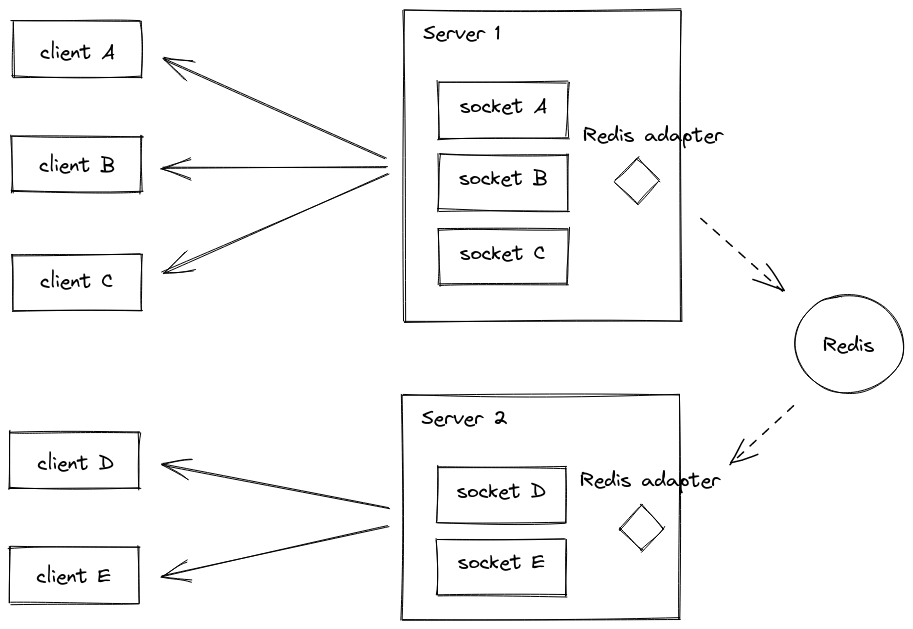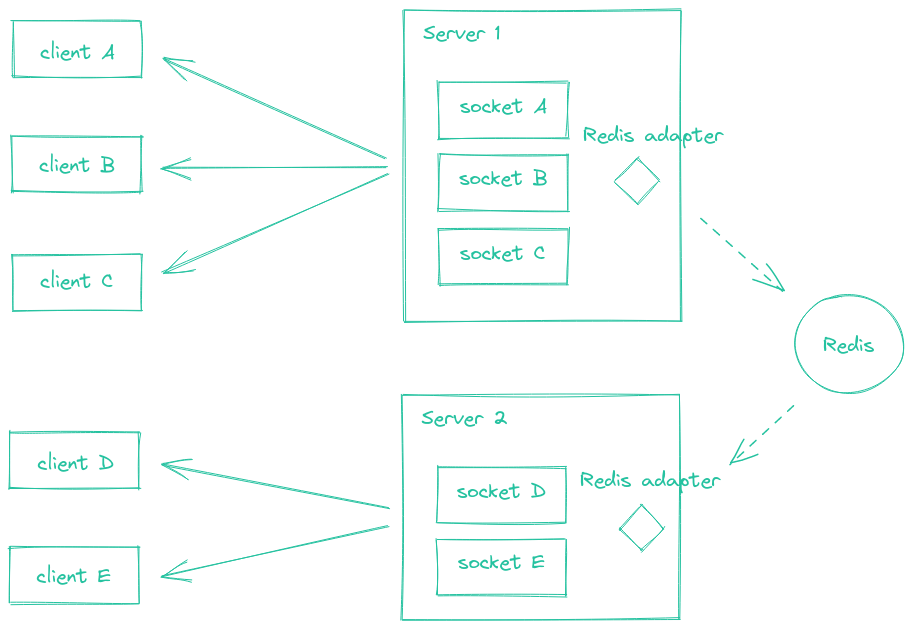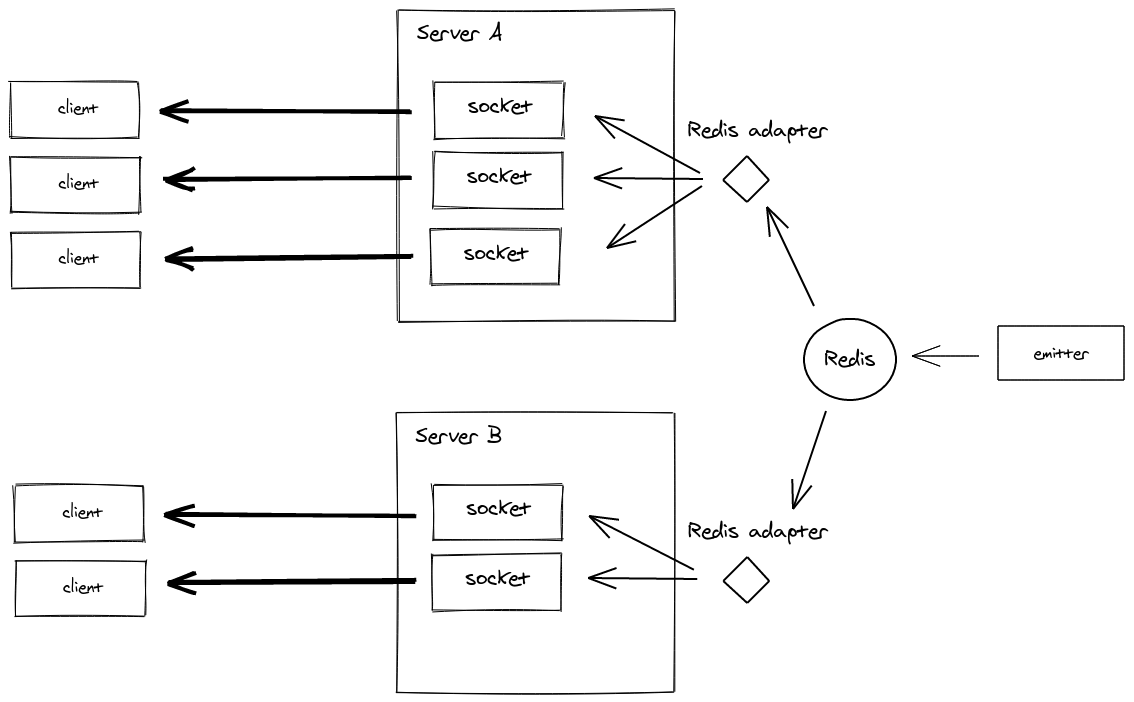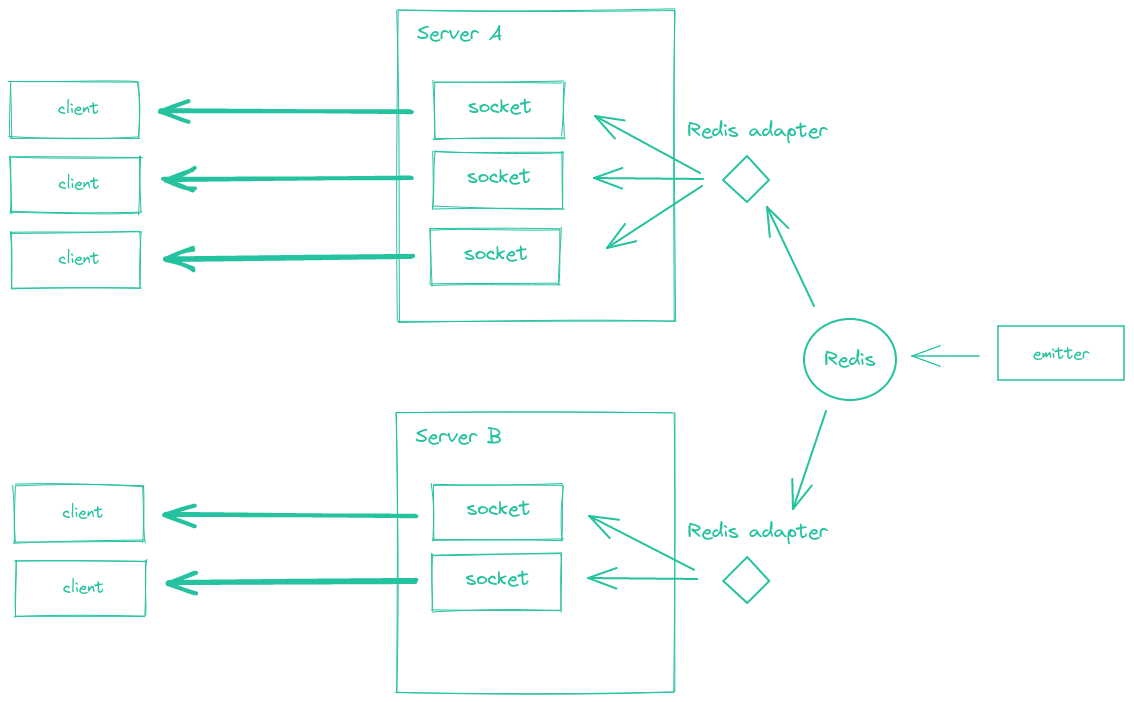Redis adapter
How it works
The Redis adapter relies on the Redis Pub/Sub mechanism.
Every packet that is sent to multiple clients (e.g. io.to("room1").emit() or socket.broadcast.emit()) is:
- sent to all matching clients connected to the current server
- published in a Redis channel, and received by the other Socket.IO servers of the cluster


The source code of this adapter can be found here.
Installation
npm install @socket.io/redis-adapter redis
For TypeScript users, you will also need to install @types/redis if you are using redis@3.
Usage
import { Server } from "socket.io";
import { createAdapter } from "@socket.io/redis-adapter";
import { createClient } from "redis";
const io = new Server();
const pubClient = createClient({ url: "redis://localhost:6379" });
const subClient = pubClient.duplicate();
Promise.all([pubClient.connect(), subClient.connect()]).then(() => {
io.adapter(createAdapter(pubClient, subClient));
io.listen(3000);
});
Note: with redis@3, calling connect() on the Redis clients is not needed:
import { Server } from "socket.io";
import { createAdapter } from "@socket.io/redis-adapter";
import { createClient } from "redis";
const io = new Server();
const pubClient = createClient({ url: "redis://localhost:6379" });
const subClient = pubClient.duplicate();
io.adapter(createAdapter(pubClient, subClient));
io.listen(3000);
Or with ioredis:
import { Server } from "socket.io";
import { createAdapter } from "@socket.io/redis-adapter";
import { Cluster } from "ioredis";
const io = new Server();
const pubClient = new Cluster([
{
host: "localhost",
port: 6380,
},
{
host: "localhost",
port: 6381,
},
]);
const subClient = pubClient.duplicate();
io.adapter(createAdapter(pubClient, subClient));
io.listen(3000);
Options
| Name | Description | Default value |
|---|---|---|
key | the prefix for the name of the Pub/Sub channel | socket.io |
requestsTimeout | the timeout for inter-server requests such as fetchSockets() or serverSideEmit() with ack | 5000 |
Common questions
- Do I still need to enable sticky sessions when using the Redis adapter?
Yes. Failing to do so will result in HTTP 400 responses (you are reaching a server that is not aware of the Socket.IO session).
More information can be found here.
- What happens when the Redis server is down?
In case the connection to the Redis server is severed, the packets will only be sent to the clients that are connected to the current server.
Migrating from socket.io-redis
The package was renamed from socket.io-redis to @socket.io/redis-adapter in v7, in order to match the name of the Redis emitter (@socket.io/redis-emitter).
To migrate to the new package, you'll need to make sure to provide your own Redis clients, as the package will no longer create Redis clients on behalf of the user.
Before:
const redisAdapter = require("socket.io-redis");
io.adapter(redisAdapter({ host: "localhost", port: 6379 }));
After:
const { createClient } = require("redis");
const { createAdapter } = require("@socket.io/redis-adapter");
const pubClient = createClient({ url: "redis://localhost:6379" });
const subClient = pubClient.duplicate();
io.adapter(createAdapter(pubClient, subClient));
tip
The communication protocol between the Socket.IO servers has not been updated, so you can have some servers with socket.io-redis and some others with @socket.io/redis-adapter at the same time.
Latest releases
Emitter
The Redis emitter allows sending packets to the connected clients from another Node.js process:


This emitter is also available in several languages:
- Javascript: https://github.com/socketio/socket.io-redis-emitter
- Java: https://github.com/sunsus/socket.io-java-emitter
- Python: https://pypi.org/project/socket.io-emitter/
- PHP: https://github.com/rase-/socket.io-php-emitter
- Golang: https://github.com/yosuke-furukawa/socket.io-go-emitter
- Perl: https://metacpan.org/pod/SocketIO::Emitter
- Rust: https://github.com/epli2/socketio-rust-emitter
Installation
npm install @socket.io/redis-emitter redis
Usage
import { Emitter } from "@socket.io/redis-emitter";
import { createClient } from "redis";
const redisClient = createClient({ url: "redis://localhost:6379" });
redisClient.connect().then(() => {
const emitter = new Emitter(redisClient);
setInterval(() => {
emitter.emit("time", new Date);
}, 5000);
});
Note: with redis@3, calling connect() on the Redis client is not needed:
import { Emitter } from "@socket.io/redis-emitter";
import { createClient } from "redis";
const redisClient = createClient({ url: "redis://localhost:6379" });
const emitter = new Emitter(redisClient);
setInterval(() => {
emitter.emit("time", new Date);
}, 5000);
Please refer to the cheatsheet here.
Migrating from socket.io-emitter
The package was renamed from socket.io-emitter to @socket.io/redis-emitter in v4, in order to better reflect the relationship with Redis.
To migrate to the new package, you'll need to make sure to provide your own Redis clients, as the package will no longer create Redis clients on behalf of the user.
Before:
const io = require("socket.io-emitter")({ host: "127.0.0.1", port: 6379 });
After:
const { Emitter } = require("@socket.io/redis-emitter");
const { createClient } = require("redis");
const redisClient = createClient();
const io = new Emitter(redisClient);